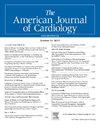Comparative Prognostic Value of Risk Factors for Predicting Pacemaker Implantation After Transcatheter Aortic Valve Replacement: A Systematic Review and Network Meta-Analysis
IF 2.1
3区 医学
Q2 CARDIAC & CARDIOVASCULAR SYSTEMS
引用次数: 0
Abstract
This study compares the prognostic value of risk factors for Permanent pacemaker implantation (PPI) following transcatheter aortic valve replacement (TAVR). PubMed, Embase, Scopus, and Cochrane Library databases were searched until November 2024 for studies reporting PPI incidence within 30 days post-TAVR. A random-effect model was used to pool risk ratios (RR) and standardized mean differences (SDM) for binary and continuous risk factors. Network meta-analysis estimated pooled risk differences (ΔRR) for binary predictors with male sex as the reference. Significant predictors were ranked based on their surface under the cumulative ranking curve (SUCRA) values. A total of 108 studies comprising 77,538 patients (14,560 requiring PPI) were included. Male sex (RR: 1.13), baseline atrial fibrillation (AF) (RR: 1.12), 2nd degree Mobitz I (RR: 5.16) and Mobitz II (RR: 2.30) atrioventricular blocks (AVB), 3rd degree AVB (RR: 13.46), left anterior (LAHB) (RR: 1.79) and posterior hemiblocks (LPHB) (RR: 2.57), bifascicular block (RR: 2.34), right bundle branch block (RBBB) (RR: 3.20) and intraprocedural AVB (RR: 4.15) were identified as predictors for PPI post-TAVR. The risk of PPI was higher with self-expandable valves (RR: 1.79), subclavian access (RR: 1.75), and 29 mm prostheses (RR: 1.33) compared to balloon-expandable valves, transfemoral access, and 23 mm prostheses. Network meta-analysis ranked 3rd degree AVB (SUCRA <0.01), Mobitz I AVB (SUCRA: 0.14), Mobitz II AVB (SUCRA: 0.33), intraprocedural AVB (SUCRA: 0.42), bifascicular block (SUCRA: 0.48), RBBB (SUCRA: 0.49) and LPHB (SUCRA: 0.54) as major predictors of PPI in descending order of significance. In conclusion, clinicians should closely monitor conduction abnormalities as key predictors of PPI following TAVR. Additionally, other risk factors such as subclavian access, self-expanding implantation, AF, large prosthesis diameter, and male sex should not be overlooked.

预测经导管主动脉瓣置换术后起搏器植入的危险因素的比较预后价值:一项系统综述和网络meta分析。
本研究比较了经导管主动脉瓣置换术(TAVR)后永久性起搏器植入(PPI)的危险因素的预后价值。检索PubMed、Embase、Scopus和Cochrane图书馆数据库,直到2024年11月,报告tavr后30天内PPI发生率的研究。采用随机效应模型汇总二元和连续危险因素的风险比(RR)和标准化平均差(SDM)。网络荟萃分析估计了以男性为参考的二元预测因子的汇总风险差异(ΔRR)。根据累积排序曲线(SUCRA)值下的曲面对显著预测因子进行排序。共纳入108项研究,包括77,538例患者(14,560例需要PPI)。男性(RR: 1.13)、基线房颤(AF) (RR: 1.12)、2度Mobitz I (RR: 5.16)和Mobitz II (RR: 2.30)房室传导阻滞(AVB)、3度AVB (RR: 13.46)、左前(LAHB) (RR: 1.79)和后半阻滞(LPHB) (RR: 2.57)、双束传导阻滞(RR: 2.34)、右束支传导阻滞(RBBB) (RR: 3.20)和术中AVB (RR: 4.15)被确定为tavr后PPI的预测因素。自膨胀瓣膜(RR: 1.79)、锁骨下通道(RR: 1.75)和29 mm假体(RR: 1.33)与球囊膨胀瓣膜、经股通道和23 mm假体相比,PPI的风险更高。网络元分析排名第三度AVB (SUCRA)
本文章由计算机程序翻译,如有差异,请以英文原文为准。
求助全文
约1分钟内获得全文
求助全文
来源期刊

American Journal of Cardiology
医学-心血管系统
CiteScore
4.00
自引率
3.60%
发文量
698
审稿时长
33 days
期刊介绍:
Published 24 times a year, The American Journal of Cardiology® is an independent journal designed for cardiovascular disease specialists and internists with a subspecialty in cardiology throughout the world. AJC is an independent, scientific, peer-reviewed journal of original articles that focus on the practical, clinical approach to the diagnosis and treatment of cardiovascular disease. AJC has one of the fastest acceptance to publication times in Cardiology. Features report on systemic hypertension, methodology, drugs, pacing, arrhythmia, preventive cardiology, congestive heart failure, valvular heart disease, congenital heart disease, and cardiomyopathy. Also included are editorials, readers'' comments, and symposia.
 求助内容:
求助内容: 应助结果提醒方式:
应助结果提醒方式:


